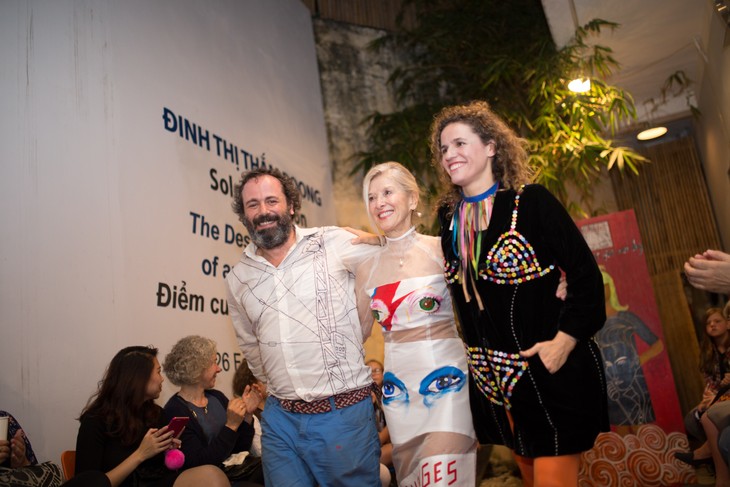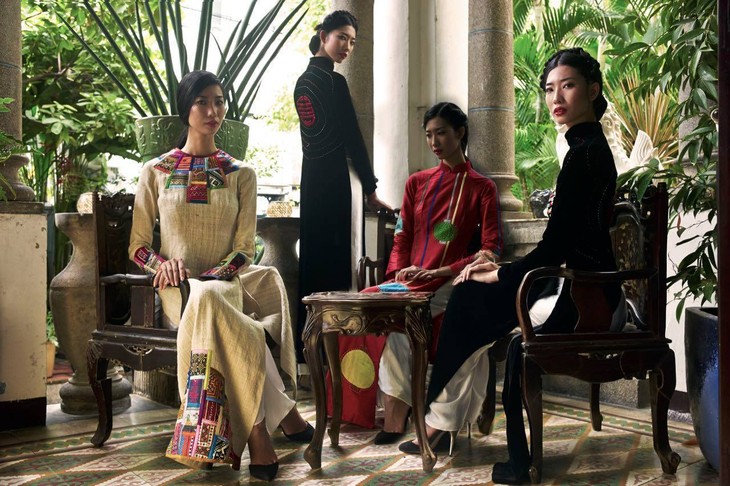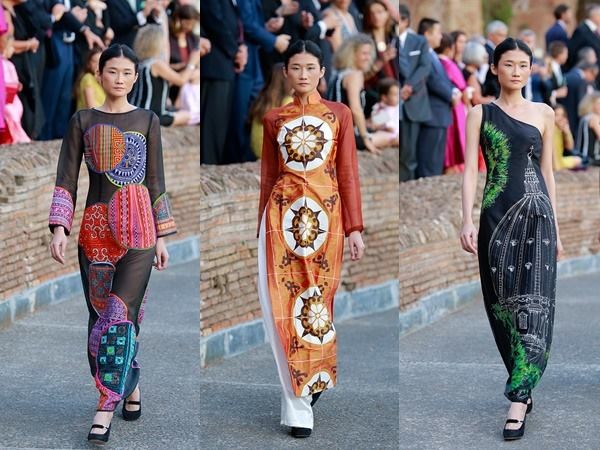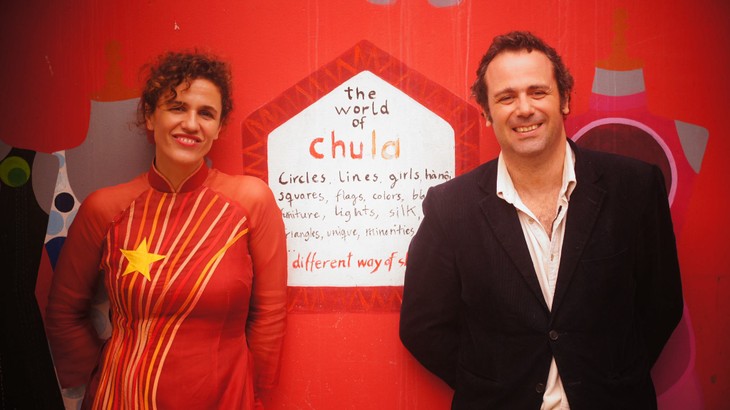(VOVworld) - The Vietnam’s traditional long dress, known as Ao Dai, has become the symbol of the Vietnamese feminine beauty, and the pride of the Vietnamese people for Ao Dai designs has been modified to be more than just a piece of traditional clothing only to wear on formal occasions. Today, we talk with Diego Chula, a Spanish fashion designer, about his passion to combine the Vietnam’s signature costumes with the modern global taste.
 |
Fashion designer Diego Chula (R) with his latest David Bowie Collection in Hanoi
(Photo: Chula)
|
Q: Hello Diego, thank you for joining us on Culture Rendezvous. Chula Ao Dai has become so popular in Hanoi now. You have opened 4 official stores in Vietnam and joined numerous cultural festivals including the recent Ao Dai Festival in Hanoi. So how long have you been working as a fashion designer in Vietnam?
A: My wife and I arrived to Hanoi in 2004. My purpose when coming here was to develop furniture design. But my wife, Laura, convinced me to start up a fashion business so we set it up together in 2005. And until now, it has been almost 11 years.
Q: A furniture designer? That was surprising! What makes you so interested in Ao Dai that you decided to switch your job and stay in Vietnam?
A: As with many other foreigners who come to Vietnam for the first time, I was really impressed with the Ao Dai because it’s the special traditional dress. For me, Ao Dai is a more modern piece of clothing if you compare with other traditional clothes not just in Asia but around the world such as the Sari in India or the Kimono of Japan. Ao Dai consists of pants and a long skirt. You also have many variations. I think Ao Dai is very useful for everyday life because you can ride a motorbike and be an independent women while wearing it. I think that’s why Ao Dai has an history of more than 100 years in use and you can still see Vietnamese women wearing it many times in the year. That’s why foreigners like Ao Dai. And to me, as a former architect, I love the decorations you can put on Ao Dai. They can be themed with landscapes, flowers and so on.
 |
| The traditional Ao Dai is actually a very modern piece of clothing, which allows women to move freely and be independent. (Photo: Official Chula Facebook) |
Q: But you’re from Spain right? Don’t you also have famous traditional clothes? Why do you still chose to work with the Ao Dai?
A: It’s true that Spain, like other Western countries, has a lot of traditions but we has lost some of them, especially in the Castile region which was famous for the embroidery motifs. Or if we go to the South of Spain, we have the dress that related to the Flamenco dance. It is a very heavy dress and it’s more for the stage or for the festival. So it’s not really useful for use in normal life. That’s why I really like Vietnam as the country has become modern now but still can keep its traditions, not only with Ao Dai but also with other textile, clothes of the minorities, the rich embroidery, and colors. We designers should feel lucky to work in a country like Vietnam.
Q: Many foreigners mistook Ao Dai with the traditional clothes of the neighboring countries, especially that of China. After working with ir for a while, how do you think?
A: It’s true that sometimes it can be difficult to tell the difference between Ao Dai and the Chinese Cheongsam. However, I truly think that the world fashion is like a symphony and each country adds a note to it. If you just copy other countries, they cannot stand out. So for Vietnam, they must keep going in their way. In Europe, we lost part of our culture because the globalization is so, so powerful. It’s important to maintain the cultural identity of a country.
 |
| To keep the traditional Ao Dai alive, it's important to introduce modern elements into it. In pictures are Ao Dai with motiffs of Vietnam's ethnic minorities or Hanoi's typical floor titles in a fashion show in Rome (Italy) in 2015. (Photo: Official Chula Facebook) |
Q: The most popular style of Ao Dai fits tightly around the wearer's upper torso, emphasizing the woman’s bust and curves. And it’s often made of silk or thin fabric. What about you, what kind of materials you choose to make Ao Dai?
A: People used to think silk is the only fabric with which to make the Ao Dai but it’s actually an open world. You can make Ao Dai from denim or wool. Last year we made Ao Dai’s with hem fabrics. We must keep the general shape of Ao Dai but in terms of materials and decorations, it’s really open.
Q: Ao Dai has experienced many modifications since its original version and some even say its history reflects the adaptability of the Vietnamese people. What do you think of that?
A: Yes, we are foreigners so we don’t really want to continue the normal Ao Dai, we would like to add some fresh air to it. In some way to keep the Ao Dai, it’s important to introduce some modern elements such as different styles, different techniques. You respect the tradition but you need to add something to it to keep the traditions alive. My Ao Dai are different. Here in Chula you can see Ao Dai with the tiled Hanoi motifs. To foreigners, the tiles of Hanoi are something very unique but floor tiles, or the street name or the flag towers are not something you usually see on Ao Dai. But I think that is the way to make them more connected to the new generation.
Q: Using totally different materials and adding daring motiffications to Ao Dai, how you can make sure your changes suit the taste of Vietnamese customers?
A: Of course, Vietnamese people are very skeptical of modern Ao Dai styles and it’s a risk for me to make them. Customers may say that: oh I don’t like this kind of style or Chu La Ao Dai is too colorful or too modern. But so far, customers’ feedback is good, not only locals but also foreigners who come to Vietnam or experts. They like it. You see, we did not make Ao Dai right away when we set up our fashion business, we only started 3 years after that. We saw it as something very respectful. When we became more confident, we asked: why don’t we make something new? Then customers came and bought Ao Dai for many different occasions. If you just keep the traditions by copying and copying, the traditions will eventually die. 100 years ago, when Vietnamese first wore Ao Dai, it was kind of a revolution: you wore pants; you wore a very, very tight dress. We need to keep the spirit that Ao Dai is revolutionary. Vietnamese people may be so used to seeing Ao Dai that you forget to see how special or how beautiful it is.
 |
| Diego and his wife, Laura, have spent more than 10 years in Vietnam to work with Ao Dai and other traditional local clothing. (Photo: Chula Official Facebook)
|
Q: Wearing Ao Dai or the traditional long dress is now very popular in Vietnam but I feel it’s still very hard to introduce the style to outside Vietnam.
A: I think last year saw a rebound of Ao Dai. The new generation is getting more interested in wearing Ao Dai. This is really, really important to this tradition of Vietnam. Vietnam has many talents with Ao Dai but they need to develop it as a signature of Vietnam, as the Scotish people do with the tartan. When you see tartan, you think of Scotland. And when you wear tartan, you don’t think: oh I’m Scottish but instead, you see you are wearing something fashionable. This is something Vietnam should consider: to turn the local Ao Dai into something international. Take Japan for example, when people see something from Japan, not only they think it’s Japanese but also think: I want to wear it. The Vietnamese are already very clear about food. When they come to Paris, they prefer to eat nice Vietnamese food. But to do that with fashion is quite challenging. It’s not about color, it’s not about textile or decoration, people need to feel proud when they wear Ao Dai.
The beauty of Vietnamese women is honoured by the Ao dai, so it is hard to think of any outfit better-suited to the Vietnamese. And I truly believe that to adapt such traditional costumes with to modern tastes is a way to preserve one significant cultural trait of Vietnam. Thank you Diego for today’s lovely conversation!
And that has been this week’s Culture Rendezous. We will see you next week!